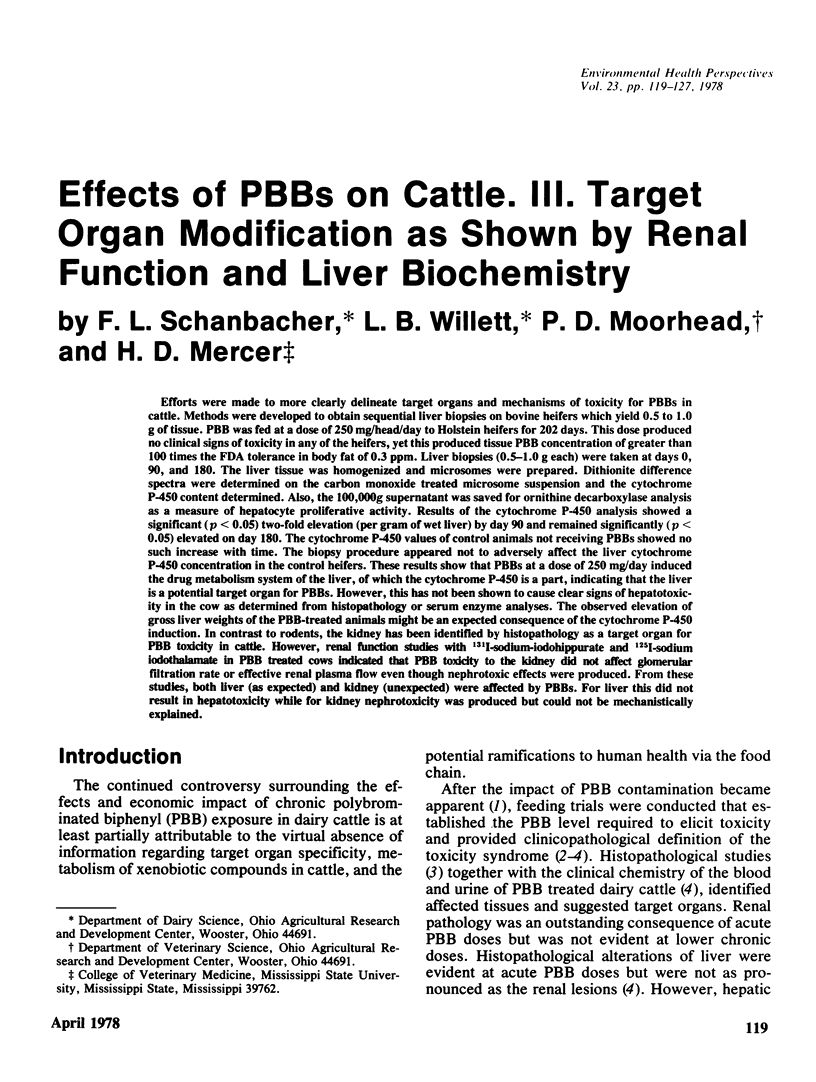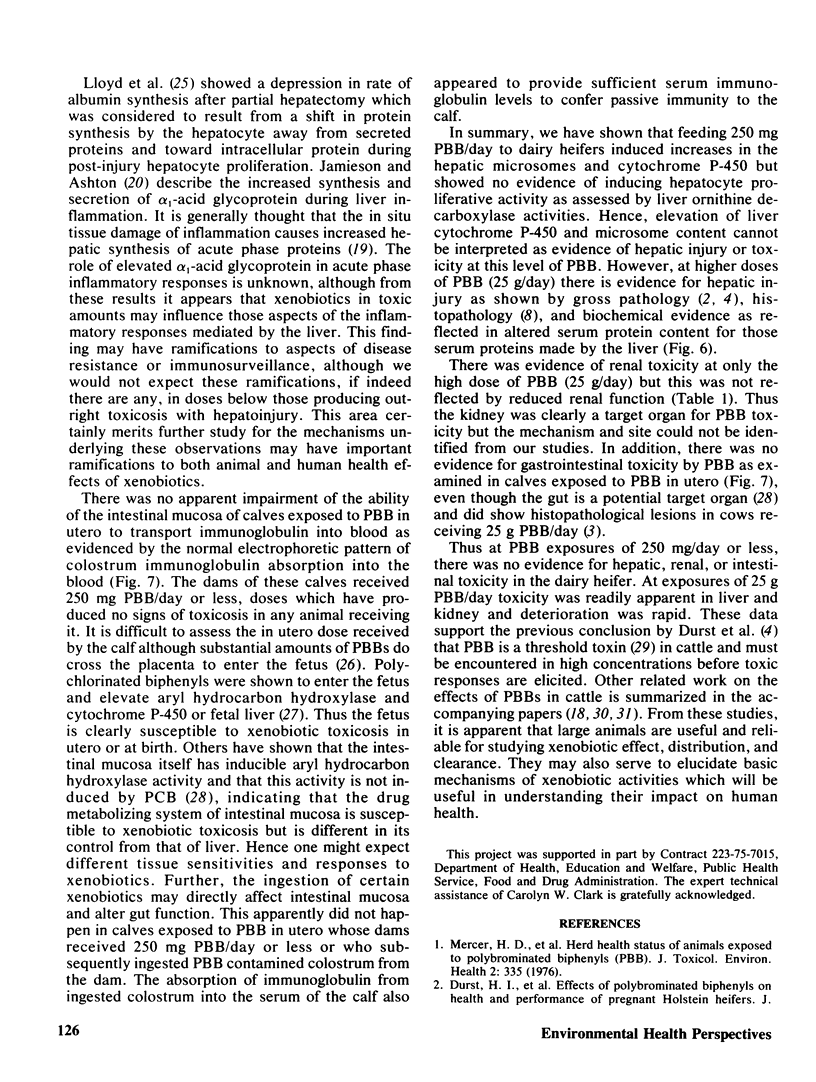Abstract
Efforts were made to more clearly delineate target organs and mechanisms of toxicity for PBBs in cattle. Methods were developed to obtain sequential liver biopsies on bovine heifers which yield 0.5 to 1.0 g of tissue. PBB was fed at a dose of 250 mg/head/day to Holstein heifers for 202 days. This dose produced no clinical signs of toxicity in any of the heifers, yet this produced tissue PBB concentration of greater than 100 times the FDA tolerance in body fat of 0.3 ppm. Liver biopsies (0.5–1.0 g each) were taken at days 0, 90, and 180. The liver tissue was homogenized and microsomes were prepared. Dithionite difference spectra were determined on the carbon monoxide treated microsome suspension and the cytochrome P-450 content determined. Also, the 100,000g supernatant was saved for ornithine decarboxylase analysis as a measure of hepatocyte proliferative activity. Results of the cytochrome P-450 analysis showed a significant (p < 0.05) two-fold elevation (per gram of wet liver) by day 90 and remained significantly (p < 0.05) elevated on day 180. The cytochrome P-450 values of control animals not receiving PBBs showed no such increase with time. The biopsy procedure appeared not to adversely affect the liver cytochrome P-450 concentration in the control heifers. These results show that PBBs at a dose of 250 mg/day induced the drug metabolism system of the liver, of which the cytochrome P-450 is a part, indicating that the liver is a potential target organ for PBBs. However, this has not been shown to cause clear signs of hepatotoxicity in the cow as determined from histopathology or serum enzyme analyses. The observed elevation of gross liver weights of the PBB-treated animals might be an expected consequence of the cytochrome P-450 induction. In contrast to rodents, the kidney has been identified by histopathology as a target organ for PBB toxicity in cattle. However, renal function studies with 131I-sodium-iodohippurate and 125I-sodium iodothalamate in PBB treated cows indicated that PBB toxicity to the kidney did not affect glomerular filtration rate or effective renal plasma flow even though nephrotoxic effects were produced. From these studies, both liver (as expected) and kidney (unexpected) were affected by PBBs. For liver this did not result in hepatotoxicity while for kidney nephrotoxicity was produced but could not be mechanistically explained.
Full text
PDF








Images in this article
Selected References
These references are in PubMed. This may not be the complete list of references from this article.
- Alvares A. P., Kappas A. Induction of aryl hydrocarbon hydroxylase by polychlorinated biphenyls in the foeto-placental unit and neonatal livers during lactation. FEBS Lett. 1975 Feb 1;50(2):172–174. doi: 10.1016/0014-5793(75)80482-0. [DOI] [PubMed] [Google Scholar]
- Brodie B. B., Krishna G., Reid W. D., Cho A. K. Drug metabolism in man: past, present, and future. Ann N Y Acad Sci. 1971 Jul 6;179:11–18. doi: 10.1111/j.1749-6632.1971.tb46887.x. [DOI] [PubMed] [Google Scholar]
- Byus C. V., Costa M., Sipes I. G., Brodie B. B., Russell D. H. Activation of 3':5'-cyclic AMP-dependent protein kinase and induction of ornithine decarboxylase as early events in induction of mixed-function oxygenases. Proc Natl Acad Sci U S A. 1976 Apr;73(4):1241–1245. doi: 10.1073/pnas.73.4.1241. [DOI] [PMC free article] [PubMed] [Google Scholar]
- Dent J. G., Netter K. J., Gibson J. E. Effects of chronic administration of polybrominated biphenyls on parameters associated with hepatic drug metabolism. Res Commun Chem Pathol Pharmacol. 1976 Jan;13(1):75–82. [PubMed] [Google Scholar]
- Dent J. G., Netter K. J., Gibson J. E. The induction of hepatic microsomal metabolism in rats following acute administration of a mixture of polybrominated biphenyls. Toxicol Appl Pharmacol. 1976 Nov;38(2):237–249. doi: 10.1016/0041-008x(76)90132-0. [DOI] [PubMed] [Google Scholar]
- Durst H. I., Willett L. B., Brumm C. J., Schanbacher F. L. Changes in blood and urine composition from feeding polybrominated biphenyls to pregnant Holstein heifers. J Dairy Sci. 1978 Feb;61(2):197–205. doi: 10.3168/jds.S0022-0302(78)83578-4. [DOI] [PubMed] [Google Scholar]
- Durst H. I., Willett L. B., Schanbacher F. L., Moorhead P. D. Effects of PBBs on cattle. I. Clinical evaluations and clinical chemistry. Environ Health Perspect. 1978 Apr;23:83–89. doi: 10.1289/ehp.782383. [DOI] [PMC free article] [PubMed] [Google Scholar]
- Fausto N. RNA and amine synthesis in the liver of rats given injections of thioacetamide. Cancer Res. 1970 Jul;30(7):1947–1952. [PubMed] [Google Scholar]
- Fouts J. R. Some studies and comments on hepatic and extrahepatic microsomal toxication-detoxication systems. A limited discussion of some of the heterogeneities of these systems and of their responses to stimulation of enzyme "induction". Environ Health Perspect. 1972 Oct;2:55–66. doi: 10.1289/ehp.720255. [DOI] [PMC free article] [PubMed] [Google Scholar]
- Jamieson J. C., Ashton F. E. Studies on acute phase proteins of rat serum. IV. Pathway of secretion of albumin and alpha1-acid glycoprotein from liver. Can J Biochem. 1973 Sep;51(9):1281–1291. doi: 10.1139/o73-168. [DOI] [PubMed] [Google Scholar]
- LOWRY O. H., ROSEBROUGH N. J., FARR A. L., RANDALL R. J. Protein measurement with the Folin phenol reagent. J Biol Chem. 1951 Nov;193(1):265–275. [PubMed] [Google Scholar]
- Lee K. P., Herbert R. R., Sherman H., Aftosmis J. G., Waritz R. S. Bromine tissue residue and hepatotoxic effects of octabromobiphenyl in rats. Toxicol Appl Pharmacol. 1975 Oct;34(1):115–127. doi: 10.1016/0041-008x(75)90180-5. [DOI] [PubMed] [Google Scholar]
- Lloyd E. A., Saunders S. J., Frith L. O., Wright J. E. Albumin synthesis and catabolism following partial hepatectomy in the rat. The effects of amino acids and adrenocortical steroids on albumin synthesis after partial hepatectomy. Biochim Biophys Acta. 1975 Aug 6;402(1):113–123. doi: 10.1016/0005-2787(75)90375-5. [DOI] [PubMed] [Google Scholar]
- Matsubara T., Koike M., Touchi A., Tochino Y., Sugeno K. Quantitative determination of cytochrome P-450 in rat liver homogenate. Anal Biochem. 1976 Oct;75(2):596–603. doi: 10.1016/0003-2697(76)90114-7. [DOI] [PubMed] [Google Scholar]
- Mercer H. D., Teske R. H., Condon R. J., Furr A., Meerdink G., Buck W., Fries G. Herd health status of animals exposed to polybrominated biphenyls (PBB). J Toxicol Environ Health. 1976 Nov;2(2):335–349. doi: 10.1080/15287397609529437. [DOI] [PubMed] [Google Scholar]
- Mitchell J. R., Snodgrass W. R., Gillette J. R. The role of biotransformation in chemical-induced liver injury. Environ Health Perspect. 1976 Jun;15:27–38. doi: 10.1289/ehp.761527. [DOI] [PMC free article] [PubMed] [Google Scholar]
- Mitchell J. R., Snodgrass W. R., Gillette J. R. The role of biotransformation in chemical-induced liver injury. Environ Health Perspect. 1976 Jun;15:27–38. doi: 10.1289/ehp.761527. [DOI] [PMC free article] [PubMed] [Google Scholar]
- Moorhead P. D., Willett L. B., Brumm C. J., Mercer H. D. Pathology of experimentally induced polybrominated biphenyl toxicosis in pregnant heifers. J Am Vet Med Assoc. 1977 Feb 1;170(3):307–313. [PubMed] [Google Scholar]
- Moorhead P. D., Willett L. B., Schanbacher F. L. Effects of PBB on cattle. II. Gross pathology and histopathology. Environ Health Perspect. 1978 Apr;23:111–118. doi: 10.1289/ehp.7823111. [DOI] [PMC free article] [PubMed] [Google Scholar]
- Morley C. G., Ho H. The regulation of mouse liver ornithine decarboxylase by metabolites. Biochim Biophys Acta. 1976 Jul 8;438(2):551–562. doi: 10.1016/0005-2744(76)90271-0. [DOI] [PubMed] [Google Scholar]
- Morley C. G. The regulation of cell growth. II. Some characteristics of a fetal calf serum factor (FF2) stimulating ornithine decarboxylase in mouse liver. Biochim Biophys Acta. 1974 Oct 8;362(3):480–492. [PubMed] [Google Scholar]
- Murphy B. J., Brosnan M. E. Subcellular localization of ornithine decarboxylase in liver of control and growth-hormone-treated rats. Biochem J. 1976 Jul 1;157(1):33–39. doi: 10.1042/bj1570033. [DOI] [PMC free article] [PubMed] [Google Scholar]
- Ono M., Inoue H., Takeda Y. Effect of thioamide derivatives on induction of ornithine decarboxylase in rat liver. Biochim Biophys Acta. 1973 Apr 28;304(2):495–504. doi: 10.1016/0304-4165(73)90269-9. [DOI] [PubMed] [Google Scholar]
- Russell D., Snyder S. H. Amine synthesis in rapidly growing tissues: ornithine decarboxylase activity in regenerating rat liver, chick embryo, and various tumors. Proc Natl Acad Sci U S A. 1968 Aug;60(4):1420–1427. doi: 10.1073/pnas.60.4.1420. [DOI] [PMC free article] [PubMed] [Google Scholar]
- Willett L. B., Brumm C. J., Williams C. L. Method for extraction, isolation, and detection of free polybrominated biphenyls (PBBs) from plasma, feces, milk, and bile using disposable glassware. J Agric Food Chem. 1978 Jan-Feb;26(1):122–125. doi: 10.1021/jf60215a004. [DOI] [PubMed] [Google Scholar]
- Willett L. B., Durst H. I. Effects of PBBs on cattle. IV. Distribution and clearance of components of firemaster BP-6. Environ Health Perspect. 1978 Apr;23:67–74. doi: 10.1289/ehp.782367. [DOI] [PMC free article] [PubMed] [Google Scholar]
- Willett L. B., Irving H. A. Distribution and clearance of polybrominated biphenyls in cows and calves. J Dairy Sci. 1976 Aug;59(8):1429–1439. doi: 10.3168/jds.S0022-0302(76)84381-0. [DOI] [PubMed] [Google Scholar]




